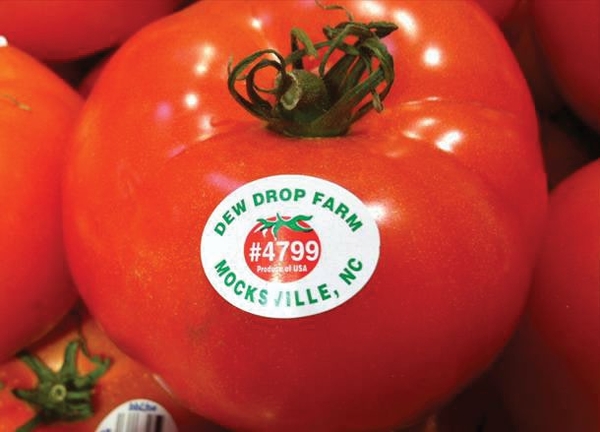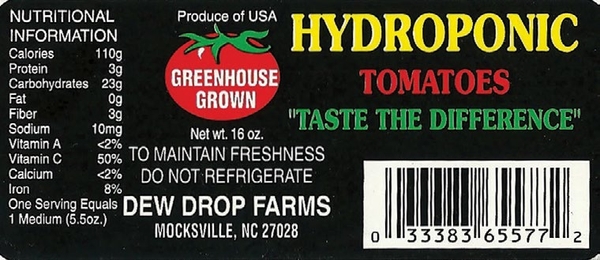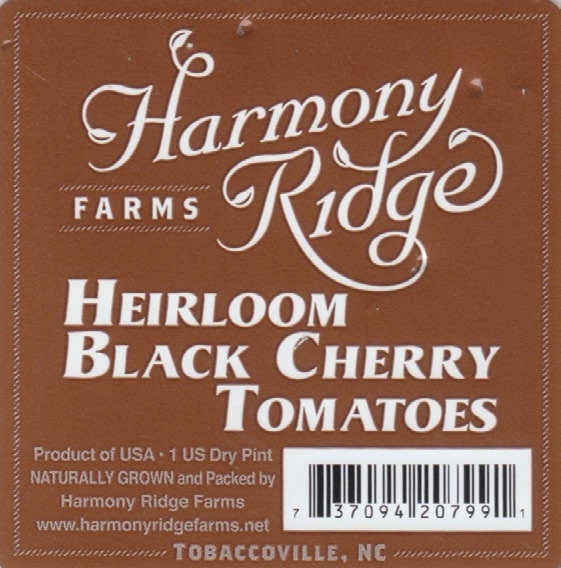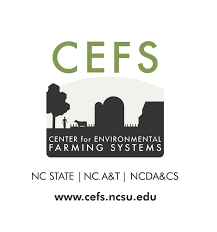PLU and UPC codes are two widely used tracking mechanisms that help retailers efficiently ring produce into the register in the checkout lane, track sales, control inventory, and market products. Being knowledgeable about these labels in advance of approaching a retailer shows a grower’s awareness of the retailer’s industry. This fact sheet contains information adapted from the Produce Marketing Association (Produce Marketing Association 2013).
PLU Codes
A PLU code, or price look up code, is a four- or five-digit identification code used exclusively in the fresh produce industry to uniquely identify a particular produce item. PLU codes are based upon commodity type, variety, and item size. You will typically find these codes on small stickers applied to individual pieces of fresh produce.
PLU codes are accepted by the produce industry for different classes of produce. For example, there are several PLU codes used for tomatoes, based on fruit size, color, and production origin (e.g., greenhouse, field, etc.). Retailers use these codes to classify specific kinds of produce so that different prices can be coded to each PLU at the checkout register.
While PLU codes stay the same for a specific product, grocery store staff are able to change the prices attached to the various codes as needed, requiring cashiers to only remember the PLU codes and not keep up with ever-changing produce prices. This system also reduces confusion between items that are charged by the each or the pound, since the PLU coding in the register will prompt the cashier for the quantity or weight, as appropriate. Having the sticker on the individual produce item allows the cashier to type in the number and accurately identify the product, weigh the item or enter the quantity, and efficiently ring up the customer’s produce at its accurate final cost. This is helpful to both the customer and retailer to ensure the correct price is assessed and to tie into the retailer’s inventory system.
Do I need a PLU sticker on my produce?
If you are selling loose, bulk, or “by the each” items to a large retail chain, it is likely the buyer will expect that PLU stickers will be placed on some items.
Many products that have multiple varieties—such as tomatoes, winter squashes, and apples—will require several different PLU codes that identify each class of produce with a separate code and sticker. Some easily identified varieties or single variety products, such as yellow squash and cucumbers, may not require a PLU sticker. For the particular crop in question, work directly with your buyer to ensure that you are using the PLU codes they require and are placing PLU stickers on the items of produce they expect you to label.
What if it is not required?
Even if a PLU sticker is not necessarily required for your item, consider using the surface of your produce item as a branding opportunity! A brand can help sell your product with relatively little inconvenience to your packing process and can help assure the customer that the product is locally grown. Even if customers do not see your sign in the store, they will see your farm name on the label once they bring your products home.
If customers want to return for more of your branded product, they just look for your label. A PLU will also allow the produce buyer or manager to recognize the demand for your item.
Take Dew Drop Farm in Mocksville, NC, for example. The PLU sticker clearly identifies the brand for customers, allowing them to look for it next time they shop for similar products.
Where can I find these codes?
You can search for PLU codes online.
Where can I order a roll of stickers?
There are several sources available that supply preprinted PLU codes, or you may desire to have custom printed PLU code stickers made. Approximate cost is $9.00 for a roll of 2,500 PLU stickers.
Two example sources are listed below.
Note: This list is not meant to be exhaustive. The inclusion or exclusion of these names on this list is not meant to imply endorsement. Additional print companies may be found with an online search for “PLU Code Label Companies.”
UPC Codes
A UPC code, or universal product code, is a twelve-digit international standard bar code that has many uses for retailers. They can use UPCs to scan items through their cash registers, to identify products, to track sales, and to manage product inventory. By connecting your UPC to their inventory system for particular items stored at their warehouse, retailers can track quantity on hand.
When would I need a UPC code instead of a PLU code?
Products that need a UPC include fixed-weight or fixed-count produce items. Examples include a three-pound bagged Gala apple or a five-pound bagged red potato, blueberry pint or grape tomato clamshells, twelve-count radish, and value-added products, such as honey.
How do I order a code?
UPCs can be unique to your item and company, or they can be generic for standard commodity-type items, such as three-pound bagged apples, blueberries, or muscadine grapes. Generic UPCs use a standard company prefix (033383), along with an item number assigned by the Produce Marketing Association (PMA), to serve as the UPC number (033383-xxxxxx).
Access to standardized, generic UPCs for fruits and vegetables is available via online subscription of $200 per year for non-PMA members. Your packaging distributor may be a PMA member who will resell you the packaging with these generic UPCs on the packages.
UPCs that are unique to your company and your product can be used for a specialty variety item, such as mixed color cherry tomatoes, or other items packaged in a special manner, such as a three-pack tomato. Unique UPCs can be obtained in two ways: through a reseller or by joining the GS1 system, an international not-for-profit association that assures unique, globally recognized bar codes.
Some retailers may require you to join the GS1 system, with an approximate $250 membership fee (for 1–10 items needing a barcode) or $750 membership fee (for 1–100 items needing a barcode) plus the print cost of the code(s). Membership must be renewed annually for a fee of $50 (1–10 items) or $150 (1–100 items).
UPC resellers are much less expensive because no membership fee applies, and the cost is about $7 for one UPC; however, you must assure this is acceptable for your buyer. Some major retailers will not accept resold UPCs because the third party seller may not be able to guarantee that a prefix is unique.
Before speaking with your buyer, learn more about GS1 versus barcode resellers by viewing the following NC Department of Agriculture and Consumer Services Got To Be NC video, “Do
I need a UPC Code?”
Note: UPC labeled products will also need a Country of Origin Label to satisfy the COOL law for packaged produce.
Where can I order UPC stickers?
If you order codes from a UPC reseller, you can receive the UPC image as a JPEG file (a common image file format) from the reseller, and then add this image to your regular farm labels using your regular printing method; or you can order a roll of stickers through the same UPC reseller. Resellers include:
Note: This list is not meant to be exhaustive. The inclusion or exclusion of these names on this list is not meant to imply endorsement. Additional resellers may be found with an online search for “UPC Reseller Companies.”
If you opt to join GS1, you will be directed to Data Driver®, their online tool for receiving the JPEG file for your UPC barcodes. You can add this to your regular farm labels using your regular printing method, or you can order a roll of stickers from a print company recommended by GS1.
For more information, visit the GS1 system website.
Access GS1’s Data Driver® tool.
Print companies for GS1 labels include:
Note: This list is not meant to be exhaustive. The inclusion or exclusion of these names on this list is not meant to imply endorsement. Additional resources may be found with online search for “GS1 Certified Print Companies.”
How do I use codes for traceability by case or pallet load?
Most wholesalers and retailers will also require a label on the case or pallet itself. At a minimum, the label should include a unique lot number, the farm name and location, and the product name, pack size, and the words “Product of the USA”. It is recommended to label each pallet with a lot code associated with a documented sanitation break in the harvest or grading process (i.e., cleaning and sanitizing your harvest bins and/or grading line). Information tied to this lot code should also be associated with inventory and field records (for example, harvest date, field number, section within a field, and harvest crew). In the event of a recall, your lot code will then be associated with a smaller and more identifiable total amount of produce.
If you sell your product by the case, each case should be labeled. If you sell your product by the pallet, each pallet should be labeled. This label will satisfy the traceability requirements of most wholesalers and retailers. However, the buyer may also request that another type of GS1 barcode label be on the case or pallet itself in addition to the individual product, this is a Global Trade Item Number (GTIN).
The Produce Traceability Initiative (PTI) is an initiative to improve traceability of produce as it flows through the supply chain. If you are GAP (Good Agricultural Practices) certified, you are required to maintain a traceability plan “one step back” (internal to your operation) and “one step forward” (external to your operation). The PTI uses a GTIN to achieve external traceability. This item number will be specific to the crop you are growing. Contact your buyer to see if you need a GTIN.
For information on GS1 Company Prefixes, visit the GS1 US® website.
For more information on produce traceability, visit:
References
International Federation for Produce Standards. 2013. “Is it required to label produce with PLU codes?” Accessed June 26, 2013.
Produce Marketing Association. 2013. “PLU Code Frequently Asked Questions.” Accessed June 26, 2013.
The Produce Traceability Initiative. 2014. Accessed July 30, 2014.
Suggested Citation
Fugate, Ariel. (2014) Tips for Marketing Fresh Produce to Retail Grocers: Understanding PLU and UPC Codes. LF-002. Raleigh, NC: The Center for Environmental Farming Systems.
Acknowledgements
Support for this publication is provided in part by NC Growing Together, a Center for Environmental Farming Systems-led initiative, funded by the United States Department of Agriculture, National Institute of Food and Agriculture, grant #2013- 68004-20363.
CEFS is a partnership of NC State University, North Carolina Agricultural & Technical State University, and the North Carolina Department of Agriculture and Consumer Services.
For more information, visit the Center for Environmental Farming Systems online.
Authors
Ariel Fugate, Center for Environmental Farming Systems
Contributions by
Patricia Tripp, Center for Environmental Farming Systems
Local Foods Publication Series Editor
Joanna Massey Lelekacs, N.C. Cooperative Extension Coordinator for Local Foods, Center for Environmental Farming Systems
Publication date: Oct. 20, 2014
Reviewed/Revised: July 11, 2024
LF-002
The use of brand names in this publication does not imply endorsement by NC State University or N.C. A&T State University of the products or services named nor discrimination against similar products or services not mentioned.
N.C. Cooperative Extension prohibits discrimination and harassment regardless of age, color, disability, family and marital status, gender identity, national origin, political beliefs, race, religion, sex (including pregnancy), sexual orientation and veteran status.






